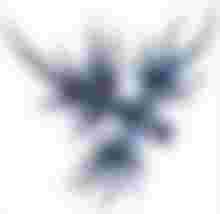Glaucus atlanticus (common names include the sea swallow, blue angel, blue glaucus, dragon slug, blue dragon, blue sea slug and blue ocean slug) is a species of small, blue sea slug, a pelagic aeolid nudibranch, a shell-less gastropod mollusk in the family Glaucidae.[2]

Glaucus atlanticusScientific classificationKingdom:AnimaliaPhylum:MolluscaClass:Gastropoda(unranked):
clade Heterobranchia
clade Euthyneura
clade Nudipleura
clade Nudibranchia
clade Dexiarchia
clade Cladobranchia
clade Aeolidida
Superfamily:AeolidioideaFamily:GlaucidaeGenus:GlaucusSpecies:G. atlanticusBinomial nameGlaucus atlanticus
Forster, 1777Synonyms[1]
Doris radiata Gmelin, 1791 (synonym)
Glaucus distichoicus d'Orbigny, 1837
Glaucus flagellum Blumenblach, 1803 (synonym)
Glaucus hexapterigius Cuvier, 1805 (synonym)
Glaucus lineatus Reinhardt & Bergh, 1864
Glaucus longicirrhus Reinhardt & Bergh, 1864
These sea slugs are pelagic: they float upside down by using the surface tension of the water to stay up, where they are carried along by the winds and ocean currents. Glaucus atlanticus makes use of countershading: the blue side of their body faces upwards, blending in with the blue of the water. The silver/grey side of the sea slugs faces downwards, blending in with the sunlight reflecting on the ocean's surface when viewed facing upwards underwater.
Glaucus atlanticus feed on other pelagic creatures, including the Portuguese man o' war and other venomous siphonophores. This sea slug stores stinging nematocysts from the siphonophores within its own tissues as defence against predators. Humans handling the slug may receive a very painful and potentially dangerous sting.

Best writing